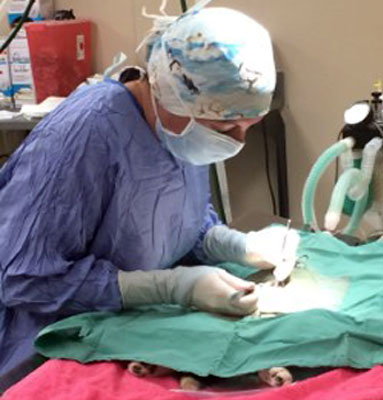By: Dr. Rainey, Staff Veterinarian, HSPPR
Providing hospice care to senior pets and/or chronically ill pets is an incredibly noble gesture – if it’s for the right pet, in the right condition. However, as a veterinarian, I know that animals often don’t show signs of discomfort, even if they are in great pain, making their stay in hospice very uncomfortable. We often get requests to adopt very old, sick animals for hospice purposes. But just because we can extend a life, doesn’t mean we should. Below are some considerations I (and my fellow veterinarians at HSPPR) take into account when looking at the overall health of a pet in our care.
Can the pet have a good quality of life in hospice?
Since we can’t directly ask our pets how they are feeling (paging Dr. Doolittle!), we have to rely on various behaviors and clinical signs to determine if they have a good quality of life. For example, the most basic questions are:
-Is the patient eating?
-Is it drinking?
-Is it using the bathroom normally, if at all?
-Is the patient showing signs of being in pain?
-Is the patient engaged in his/her surroundings, responding positively to interactions (human and/or animal), and/or wanting to participate in activities?
-Is the animal having more “good” days than “bad?”
If the answer is “no” to one or more of these questions, can we realistically treat the pet to change the answer to “yes”? Can we realistically intervene with this patient so that we can improve his/her quality of life, even if for only a short period of time? If yes, then hospice is a reasonable choice.
Is medical intervention a “realistic” option for the pet?
Realistic medical intervention means:
-The intervention needs to work. For example, if the problem is chronic vomiting because of gastrointestinal cancer, the medications given need to control the vomiting. Otherwise, the patient is still suffering.
-The intervention/management of the patient needs to be ongoing. This means dedicated care from the people who are providing it. In chronic illness and disease, constant care, attention and monitoring must be provided. Otherwise, the patient will suffer.
-Ask the question: Are there sufficient resources to provide the appropriate intervention and/or management and continue it as long as your pet needs it? If those wanting to provide hospice care do not realistically have the monetary, time, or other pertinent resources to appropriately care for the patient, then he/she will inevitably suffer.
If not hospice, then what?
The bottom line is that appropriate hospice care must be defined as the ability to provide suitable, dedicated care that successfully alleviates the patient’s suffering for a certain amount of time, so that they can enjoy a good quality of life for as long as possible. If this cannot be provided, then the animal will suffer. In these situations, euthanasia is the only humane option, and, contrary to popular belief, humane euthanasia is one of the greatest gifts we have in veterinary medicine because it mercifully ends suffering.
Deciding if hospice or humane euthanasia is right for your pet can be an incredibly emotional and difficult choice, so we recommend consulting with your pet’s veterinarian for support in this decision. If you are unsure of where to go for affordable and humane euthanasia, HSPPR offers this service.








